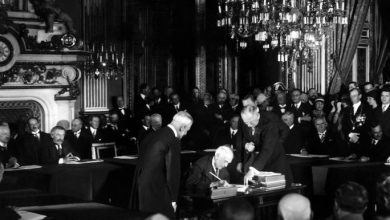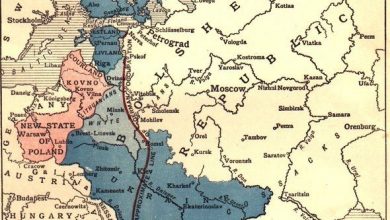Never Again a Ninth of April – When Denmark was invaded by Nazi Germany

On April 9th 1940, the Kingdom of Denmark came under assault from Nazi Germany, marking the beginning of Nazi occupation of the country. On the day prior to the assault, the Danish military had informed the Danish government that Germany was amassing troops on the border. Invasion was expected to follow on the 9th. The Danish military requested to be allowed to deploy in defensive positions. Fearing that such a provocation would be the cause of war, the government decided to reject the military’s request. This rendered Denmark near defenceless while the Kriegsmarine, Nazi Germany’s navy, was sailing towards Norway. The events which ensued are both a symptom of the past and a turning point in Scandinavian history.
A History of Denmark
Denmark is unconquered in known history. The only other country which claims this title is Japan. Both have royal lineages going back over a thousand years. The have both been occupied, but neither has been anything but the primary element of any entity which they may have been part of. This shaped the narratives and perceptions of key relevant players during the spring of 1940.

Denmark is small today, but it was not always so. As vikings, Danes dominated the North Sea. Later unifying with Norway and Sweden into the Kalmar Union, Denmark was a formidable power in the Baltic Sea, which no ship could enter or leave without paying the King’s toll. However, the Kalmar Union was a medieval construction, and soon the Danish king eliminated it along with significant elements of the Swedish (pro-independence) elite in 1520.
In many ways, from this point on the path was all downhill for Denmark, which from 1523 was known as the Kingdom of Denmark and Norway. With the old rival in the Hanseatic League gone, Sweden rose to be the new contestant for control of the Baltic Sea region. This was cemented during the Thirty Years War (1618-1648), where Denmark intervened first, failing, while Sweden coordinated their intervention with France, which ended up proving successful.
Ten years later Sweden would conquer the provinces of Scania, Halland, and Blekinge, which were Danish of language and mindset. Their loss effectively ended Danish monopoly on passage into the Baltic Sea. Denmark, along with Russia and Poland, tried several times to end the now Swedish Empire, but it was not until Sweden choose to support the wrong side in the early parts of the Napoleonic Wars that this happened.
Sweden was forced to cede Finland to Russia in 1809 and Denmark, which had also supported Napoleon ,was forced to compensate Sweden with Norway proper (not including Faroe Islands, Iceland, and Greenland) in 1814. Sweden was lost, Scania was lost, and Norway was lost as well: could it get any worse for Denmark?

With the rise of nationalism, the German speaking Duchies of Slesvig and Holsten were now building a German identity. Holsten was German, while Slesvig was split between Danish and German speakers. However, these lands were of significant importance for Denmark as they were the home of the Danish royal family.
Following the Napoleonic Wars the Duchy of Holsten joined the fledging German Confederation, while Slesvig did not. However, Slesvig and Holsten were bound to stay together, so when the Spring of Nations in 1848 had brought liberal constitutions to many European states, Holsten rose to leave Denmark (along with elements of Slesvig) and fully join the German Confederation. After three years of war the rebellion was put down, but it would seem it was only a matter of time before Holsten would leave Denmark with Prussian and/or Austrian aid.
This came to pass in 1864, when Austria and Prussia set aside their battle for hegemony within the German Confederation, and instead took not only Holsten, but also all of Slesvig from Denmark. After past losses, now another third of Danish territory was lost. Danish independence seemed to only exist at the will of Prussia. The motto of the era inside Denmark became “what is externally lost, we will internally gain”.
And so the old dominating power in Northern Europe was now without a meaningful foreign policy. A hope for Pan-Scandinavianism has also failed as Sweden choose not to intervene to support Denmark in 1864. This was the final nail in coffin for Danish greatness. Prussia went on to defeat first Austria and then France to unite Germany under the Prussian King. Peace would follow in Europe for over 40 years, until the First World War.
Many Danish speakers involuntarily served in the German military, but Denmark could do nothing but declare its neutrality. Sweden did the same, and so did a now independent Norway. There was an understanding that if one Scandinavian country was attacked, they would aid each other, but Pan-Scandinavianism had already failed in 1864, so it was unlikely to be the factual reality if anyone (likely Denmark) was actually invaded.

Norway had been an integral part of the Kingdom of Denmark and Norway, but after the split, they had never been happy with being ruled by Sweden, and in 1905 Norway gained independence. The young Norwegian nation felt ignored by Denmark throughout their time in the dual kingdom (and the Kalmar Union before that), so the Norwegian narrative designated it the 400 Years Night, which was followed by (about) 100 years of Swedish occupation.
The First World War profoundly influenced the Norwegian economy as they were free to trade with the warring parties and had one of the largest merchant fleets in the world. The Entente victory also meant France wanted to weaken Germany, and offered Denmark to revert to the borders before 1864. Being fearful of the next war, Denmark chose to hold a plebiscite to determine what territory wanted to rejoin the Kingdom and leave those wishing to remain Germans to Germany.
For the first time in centuries Denmark had gained territory, but it was still a very small State facing a revanchist Germany waiting for its chance to reassert itself. Danish independence was still at the sufferance of the German government in Berlin.
The Second World War
Fast-forward to 1939 when events started to speed up. Germany invaded and split Poland with help from the Soviet Union, and the UK and France declared war on Germany. The Reich attempted to starve the UK out of the war by blockading them using submarines (as had been attempted in the First World War) and what few surface ships they had.
The German Kriegsmarine had their heart set on the Norwegian fjords as a base for breaking out into the Atlantic, and they needed to secure the iron ore supply from Northern Sweden which was shipped out through the Norwegian port of Narvik. So when Norway failed to defend its neutrality in the Altmark Incident, Germany started to make plans for war. At the same time the allies were making plans for seizing Narvik.
However, Norway was not just trapped between a rock and a hard place. They also had a land border with the Soviet Union, which had annexed part of Poland, the Baltic states, and was at war with Finland. Norway seemed just as much threatened by the USSR as anyone else. All of Scandinavia had done as much as they could to aid Finland, without actually joining the Winter War, but Finland still had to accept the war was unwinnable, and settled for a deal with the Soviets.
Sweden was however isolated. They had Norway and Finland as cover against the USSR, Norway against the allies, and Denmark against Germany. So as Norway could trade with both sides in 1914-1918, now Sweden had the same option. And all of Sweden, Norway, Denmark, and Finland had declared their neutrality at the outbreak of war as was the Scandinavian tradition.
For Denmark the question of independence at the will of Berlin was still in effect, and it would either have to side with Germany or be occupied. So delaying this eventuality as much as possible was the aim of Danish foreign policy. However, what the Danes did not know was that for an invasion of Norway the Wehrmacht would show their Fallschirmjägers off to the world for the first time. And the distance to Norway by transport plane in 1939 was significant, so Germany would have to take Aalborg Airfield in Northern Jutland as a stop off point. This meant there was no alternative to an invasion of Denmark as well as Norway.
On April 8th 1940, the Royal Navy and Kriegsmarine near simultaneously set sail for Norway. The Royal Navy attempted to mine the Norwegian Fjords (an act of war against Norway), the Kriegsmarine tried to land an invasion force. German forces massed on the Danish border.
April 9
The Germans overran Danish defences with relative ease. Luftwaffe bombers circled Copenhagen, threatening to bomb the capital if Denmark failed surrender. Denmark surrendered, avoiding the fate that would later befall Rotterdam, which was decimated in the summer. Even a mobilisation and a fight on the border would have been pointless. Not only was Denmark invaded by land, but troops are also landed from the sea and by air at Aalborg to secure the airfield. This marked the first land-air-sea invasion in military history.
Norway had typography on its side and fought back desperately. The war continued with allied landings, but eventual evacuation that summer, following the beginning of the Ardennes Offensive in the West.
Aftermath

Denmark as a non-resistant was “peacefully occupied” – meaning the Danish Government was allowed to run the country until 1943, when it simply resigned. This was by many seen as collaboration with the Third Reich. However, Danish resistance eventually got off their feet in 1941 after Operation Barbarossa, and this was also the cause of the government being eventually forced to step down by German pressure.
A vast majority of Danish Jews were evacuated to Sweden before the Gestapo could capture them. Norway faced a much harder occupation with an active resistance – especially in relation to ending the German nuclear weapons program by destroying the heavy water plant in Norway – the only such plant in the Axis controlled part of Europe).
When the war ended, Norway had been an occupied ally. Sweden was an untouched neutral country, but had been pro-German in an effort to preserve its independence. Finland had been a German ally in the invasion of the Soviet Union, and their independence was at the mercy of the USSR… But what about Denmark?
The country failed to fight back, had been overly cosy with the Germans, and had done little to nothing in terms of winning the war for the allies. The Norwegian government in exile in London had called for Denmark to pay reparations to Norway for their inaction, but when the news reached Norway, the Government was kindly reminded that without Danish food supplies to Norway during the war, Norway would have faced starvation. Unlike 1648, 1815, and 1864, Denmark ended up on the right side of history.
Following the war Sweden maintained their neutrality. Finland was forced into neutrality to maintain actual independence from the later Warsaw Pact. Norway stayed an ally. Denmark pushed for a Nordic defence union, but quickly realised that Norway and Sweden were not going to agree. Under the believed threat

of a Soviet invasion, they chose to follow Norway as a founding member of NATO.
Nevertheless, in the Danish mindset the Second World War had been just as much failure as 1864. And this time the Danish Army had not even shown up on the battlefield. The young nation of Norway had defined its existence as a fighting ally amongst the united nations of the free world. Denmark was still a failure. And how would Denmark be able to face the Soviet Union’s Warsaw Pact if they wished to gain access the North Sea?
A new organisation was formed, called the Danish Home Guard. Its motto is “Never Again a Ninth of April”. Their aim is to supplement the Danish Army, and be ready to fight for their homes, villages, towns, and cities – thereby allowing Danes to fight back even in the event that Denmark failed to defend its sovereignty once more.
It can be debated if the Danish participation in the 2003 Iraq war marks the first time Denmark as a belligerent actually won a war in narrative memory. Some historians argue this as the end of the 1864 trauma, and the rebirth of the viking warrior nation, but this narrative is often exaggerated. What, however, is important to note is there has never been another Ninth of April. Denmark today is safely integrated into NATO and the EU, and surrounded by friends.





